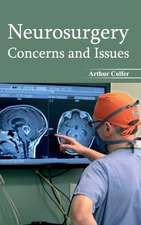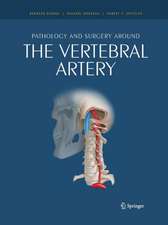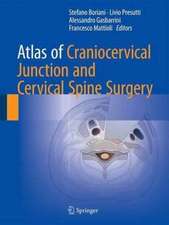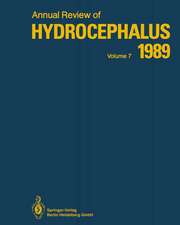Hydrocephalus: Pathogenesis and Treatment
Editat de Satoshi Matsumoto, Norihiko Tamakien Limba Engleză Hardback – 29 dec 1991
| Toate formatele și edițiile | Preț | Express |
|---|---|---|
| Paperback (1) | 397.62 lei 6-8 săpt. | |
| Springer – 18 ian 2012 | 397.62 lei 6-8 săpt. | |
| Hardback (1) | 433.35 lei 39-44 zile | |
| Springer – 29 dec 1991 | 433.35 lei 39-44 zile |
Preț: 433.35 lei
Preț vechi: 456.15 lei
-5% Nou
Puncte Express: 650
Preț estimativ în valută:
82.92€ • 88.67$ • 69.14£
82.92€ • 88.67$ • 69.14£
Carte tipărită la comandă
Livrare economică 14-19 aprilie
Preluare comenzi: 021 569.72.76
Specificații
ISBN-13: 9784431700807
ISBN-10: 4431700803
Pagini: 724
Ilustrații: XVII, 702 p.
Dimensiuni: 168 x 240 x 44 mm
Greutate: 0 kg
Editura: Springer
Colecția Springer
Locul publicării:Tokyo, Japan
ISBN-10: 4431700803
Pagini: 724
Ilustrații: XVII, 702 p.
Dimensiuni: 168 x 240 x 44 mm
Greutate: 0 kg
Editura: Springer
Colecția Springer
Locul publicării:Tokyo, Japan
Public țintă
ResearchDescriere
During the past ten years, technology has been progressing at a rapid pace in the field of medical science, and there have been great improvements in the basic understanding, diagnosis, and treatment of hydrocephalus. The present volume contains the proceedings of the International Symposium on "Hydrocephalus" that was held in Kobe, Japan, from November 12-14, 1990. The purpose of the symposium was to highlight the recent advances in this field and to provide a unique opportunity for exchange of basic and clinical knowledge among experts in this field. During the symposium, 84 papers were presented by 240 contributors from 14 countries. This volume is a compre hensive description of the current knowledge in this area, and it may help to define what is known and to find new strategies to understand the patho genesis, pathophysiology, diagnosis, and treatment of the hydrocephalic process. The editors take great pleasure in expressing their thanks to the contributors for their participation and cooperation, and to Springer Verlag for personal and technical assistance in publishing the proceedings. We sincerely hope that this volume will contribute to improving the treat ment for hydrocephalus. August 1991 The Editors V Contents Preface.......................................................... V List of Contributors . . . . . . . . . . . . . . . . . . . . . . . . . . . . . .. . . . XV . . . . . . . . . . . . . Special Exhibition 1 Hydrocephalus: Historical Review H. Sato and S. Matsumoto. . . . . . . . . . . . . . . . . . . . . . . . . . . 3 . . . . . . . . . . .
Cuprins
Special Exhibition.- 1 Hydrocephalus: Historical Review.- Pathogenesis of Hydrocephalus.- I. Morphological and Biochemical Aspects.- 2 Early Vs Delayed Ventriculoperitoneal Shunt—Effects on the Impairment of the Developing Brain in Congenitally Hydrocephalic HTX—Rats.- 3 Embryopathoetiology of Congenital Hydrocephalus in Experimental Models: A Comparative Morphological Study in Two Different Models.- 4 Postnatal Changes of HRP—Labeled Corticospinal Neurons in Congenital Hydrocephalic Rats (HTX).- 5 Changes in the Cerebral Vascular Bed in Experimental Hydrocephalus: An Angioarchitectural and Histological Study.- 6 Impaired Synaptic Plasticity and Dendritic Damage of Hippocampal CA1 Pyramidal Cells in Chronic Hydrocephalus.- 7 Neurotransmitter Changes in Hydrocephalus: Effects of Cerebral Metabolic Activator on Kaolin—Induced Hydrocephalus.- 8 Changes in the Hypothalamic and Brain Stem Catecholaminergic Systems in Experimental Hydrocephalus: A Histochemical Observation.- 9 Regional Changes in Superoxide Free Radicals, Energy Metabolism, and Ca—Calmodulin Binding Protein in the Development of Congenital Hydrocephalus.- II. Cerebral Hemodynamics and Metabolism.- 10 Cerebrovascular Flow and Glucose Transport in the Hydrocephalic Rat.- 11 Effects of Ventricular Enlargement of Experimental Hydrocephalus on the Regional Cerebral Blood Flow, Somatosensory Evoked Potentials, and Biomechanical Factors.- 12 High Energy Phosphate Metabolism in Congenital Hydrocephalic Rats — an in Vivo 31P Magnetic Resonance Spectroscopy Study.- 13 Cerebral Hemodynamics in Hydrocephalus During Infancy: Experimental and Clinical Studies.- 14 Cerebral Blood Flow and Oxygen Metabolism in Children with Hydrocephalus.- 15 Pulsatile Flow in Cerebral Arteries in Neonatal Hydrocephalus.- 16 Crossed Cerebellar Diaschisis in Hydrocephalus — Report of Three Cases.- 17 CSF Absorption Rates in Cats with Kaolin-Induced Hydrocephalus — a Study Using Different Kinds of Tracers of Different Molecular Size.- 18 Subependymal CSF Absorption in Hydrocephalic Edema — Ultrastructural Localization of Horseradish Peroxidase and Brain Tissue Damage.- 19 CSF Flow Dynamics in External Ventricular Drains.- 20 Evidence of CSF Flow in Rostral Direction Through Central Canal of Spinal Cord in Rats.- 21 Pathogenesis of Syringomyelia with Description of Non—Communicating Type That Arises Immediately Caudal to Obstructive Lesions.- 22 Potential Difference Records from Human Cerebrospinal Fluid.- 23 Cerebral Evoked Potentials in Rats with Congenital Hydrocephalus.- 24 Clinical Significance of ICP Measurement in Infants Part I: Normal Intracranial Pressure.- 25 Clinical Significance of ICP Measurement in Infants Part II: Intracranial Pressure in Infants with Hydrocephalus.- 26 A Volume—Blood Flow Velocity Response (VFR) Relationship Derived from CSF Compartment Challenge as an Index of Progression of Infantile Hydrocephalus.- 27 The Role of Altered Brain Properties in Ventricular Dilatation.- 28 Biomechanical Analysis of Hydrocephalus by Different Physical Models.- Treatment of Hydrocephalus.- I. Hydrocephalus of Various Etiologies.- 29 Management of Hydrocephalus Secondary to Posterior Fossa Tumor in Childhood.- 30 Traumatic Brain Edema in the Pathogenesis of Post-traumatic Hydrocephalus.- 31 Treatment of Postmeningitic Hydrocephalus.- 32 “Benign” Intracranial Hypertension and Polyradiculitis — Two Varieties of One Disease?.- 33 Surgical Management of Hydrocephalus Accompanying Cystic Lesions in Infancy.- 34 Pathophysiological Considerations of Subdural Fluid Collection in Childhood.- 35 Hydrocephalus — Revision of its Classification.- II. Shunt Systems.- 36 The Effectiveness of a Siphon Control Device in Preventing the Complications of Overshunting.- 37 Importance of Anti—Siphon Devices in Shunt Therapy of Pediatric and Adolescent Hydrocephalus.- 38 The Antisiphon Device — its Value in Preventing Excessive Drainage.- 39 Effect of an Anti-Siphon Device in Shunting Procedure: Intraventricular Pressure During Posture Changes.- 40 Sophy Shunts in the Treatment of 130 Patients.- 41 Pitfalls of the Sophy Programmable Pressure Valve: Is it Really Better than a Conventional Valve and an Anti—Siphon Device?.- 42 A New Shunt System with Non—Invasive Flow Rate Regulation and Pressure Measurement.- 43 A New Curved Peritoneal Passer for Shunting Operations — Technical Note.- 44 Hydrogel Ventriculo-Subdural Shunt for the Treatment of Hydrocephalus in Children.- III. Shunt Complications.- 45 Evaluation of Shunt Failures by Compliance Analysis and Inspection of Shunt Valves and Shunt Materials, Using Microscopic or Scanning Electron Microscopic Techniques.- 46 Shuntography for Functional Evaluation of Ventriculo—Peritoneal Shunt in Children.- 47 Measurement of CSF Shunt Flow with MR Phase Imaging.- 48 A Trial for the Evaluation of CSF Shunt Function Using MR Imaging.- 49 An Evaluation of the Use of Perioperative Antibiotics in CSF Shunts.- 50 A Concerted Effort to Prevent Shunt Infection.- 51 Post—Shunt Isolated Compartments in Hydrocephalus: Proposal for a New Classification and Experimental Proof of the Pathophysiology.- IV. Neonatal and Childhood Hydrocephalus.- 52 Epidemiological Survey of the Management of Fetal Hydrocephalus in the Kansai District of Japan.- 53 Congenital Central Nervous System Malformations Associated with Hydrocephalus.- 54 Ventriculo—Peritoneal Shunt as an Initial Treatment Modality for Premature Infants with Hydrocephalus.- 55 Surgical Outcome of Neonatal Hydrocephalus.- 56 Reduction Cranioplasty for Congenital Hydrocephalus.- 57 Effect of Ventricular Size on Intellectual Development in Children with Myelomeningocele.- 58 Continuous Cerebral Blood Flow Velocity (CBFV) and Simultaneous Intraventricular Pressure Measurements During Sleep in Hydrocephalic Children.- V. Normal-Pressure Hydrocephalus.- 59 Lumboperitoneal Shunt for Communicating Hydrocephalus.- 60 Properties of Interstitial Fluid in the Cerebral White Matter of Patients with Normal Pressure Hydrocephalus.- 61 Quantitative Criteria for Successful Outcome in Shunting Operations.- 62 The Implications of Shunt Surgery in the Intracranial Hydrodynamics of Normal Pressure Hydrocephalus (NPH).- 63 Preoperative Evaluation of Normal Pressure Hydrocephalus by Transcranial Doppler Sonography.- 64 Reversibility of Dementia in Hydrocephalus After Shunt Surgery: A Comparative Study of Elderly and Non—Elderly Patients.- 65 Clinical Evaluation of Sophisticated Mental Tests and 123I—IMP SPECT in Normal Pressure Hydrocephalus (NPH) Patients.- VI. New Concepts and Future Aspects.- 66 Serotonergic Effects on Cerebrospinal Fluid Production.- 67 Alterations of Atrial Natriuretic Peptide Receptors in the Choroid Plexus of Rats with Kaolin—Induced Hydrocephalus.- 68 Effects of Atrial Natriuretic Peptide on Intraventricular Pressure in Rats with Congenital Hydrocephalus.- 69 “Neuroendoscopic Third Ventriculostomy”.- 70 New Surgical Therapy for Hydrocephalus: Percutaneous Flexible Endoneurosurgical Choroid Plexus Coagulation.


















